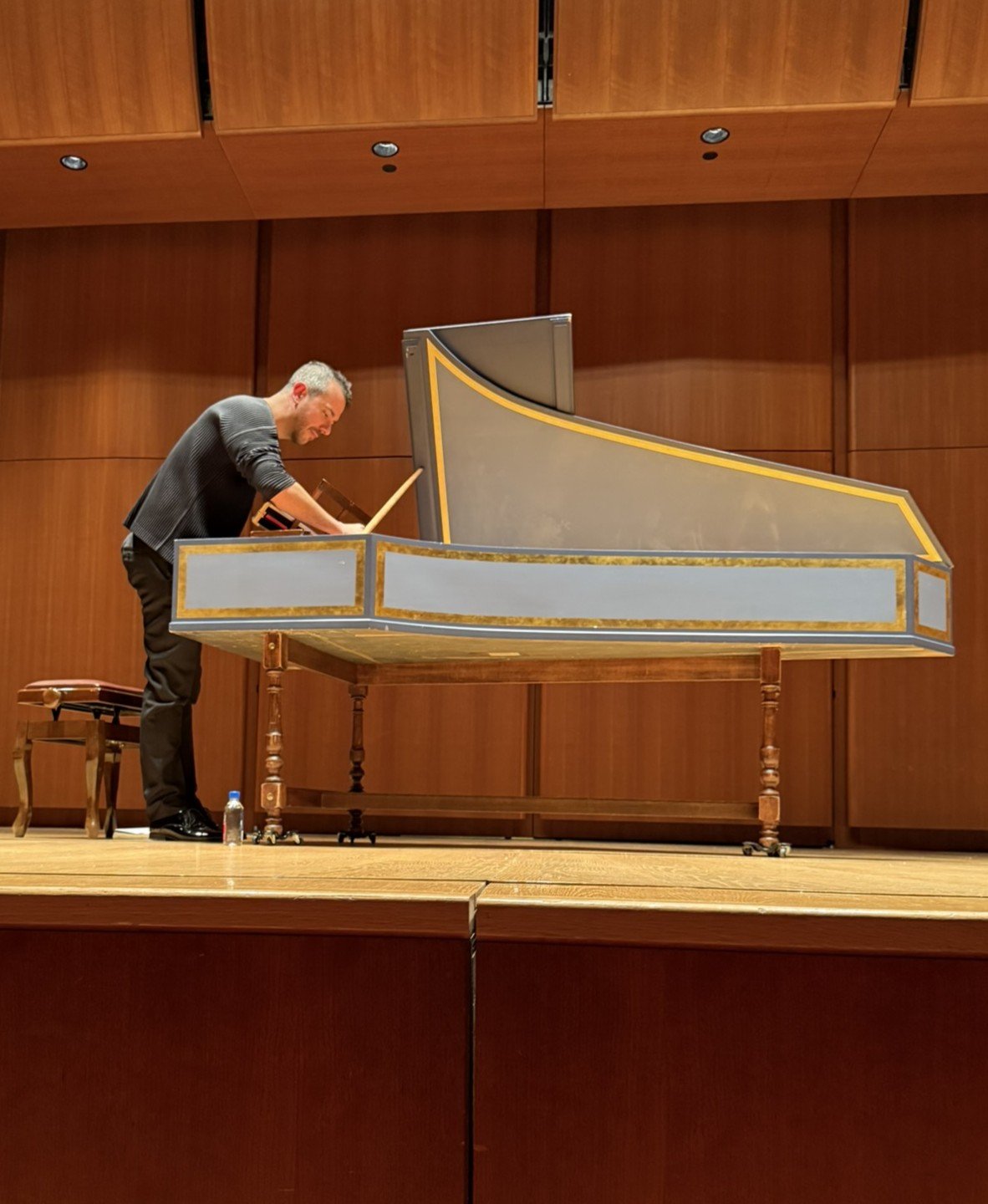It has been a few days since I heard Francesco Corti's harpsichord at the Morgan Library in New York. I witnessed an archaeologist discover a Lamborghini due to an extraordinary excavation. One harpsichord produced various tones like an orchestra, and every time the track changed, I was visiting a different country. Corti's winged hands exquisitely blended dance music with roots in various countries, created in the early 18th century in Europe, where it was becoming more international. In the opening of Giulio Cesare's Overture, I felt the unique floating French feeling that Yannick showed at some Opera at the Met Opera. I enjoyed the gorgeous ornaments hidden behind the simple melodies in the following suites by Handel and Bach. The passages were repeated, full of vivid play, and I was excited by the encounter with another world. In William Babell's arrangement, the gorgeous decoration of the Adagio reminds me of Handel at that time and the longing sigh for freedom in Rinaldo's aria by Corti's delicate and nuanced agogics, and I realized Bach comes to my mind, but Handel comes to my instinct,
Corti was precise at any tempo and vividly conveyed the charm of the music. Whether played fast or slow, the passages are perfectly controlled, and the charm of the music is fully demonstrated. Corti describes the Allemand from Bach's French Suite as cantabile (sings well), and the theme that appears repeatedly in the Allemand is well sung. In the following Courant, the tempo changes to slow, and it seems as if you can see good Italian weather and hear a lute play by the water. In the English country dance, Sieg, the sound jumps and gives endless joy. In Handel's Suite No. 3, the performance progressed from the Prelude to the Allegro Fugue and Allemande, and from the Aria with five variations to the Presto, he showed a perfect fusion of styles. In the program, Corti's tonal combinations reminded a variety of instruments, from a single harpsichord to lutes, guitars, oboes, and people’s singing, and showed me as if the orchestration changed in each piece on the stage. Corti's performance through Handel and Bach showed me that music is always close to people's hearts and lives, freeing us from eras and styles and providing clues to stimulate new interests that will come.
フランチェスコ・コルティのハープシコードをニューヨークのモーガンライブラリーで聴いて数日たった。まるで考古学者が発掘調査の結果、ランボルギーニを発見する様子を目の当たりにしたような、今思うと大変なもの見た気がする。一台のハープシコードはオーケストラの様にさまざまな音色をはじきだし、トラックが変わる度に全く違う国を訪れたような感覚になった。18世紀初頭の国際化が進むヨーロッパで作られた異なる国々にルーツを持つダンスミュージックをコルティの翼のような両手は絶妙に融合する。ジュリオ・チェーザレのオープニングでは、年末のメットで見た影のない女の冒頭でヤニックが見せたフランス音楽独特の浮遊を感じ、続くヘンデルとバッハの組曲ではシンプルなメロディの奥に華麗な装飾の数々を味わう。パッセージは繰り返され、鮮やかな遊びに満ち、別世界の遭遇に胸を躍らせた。ウィリアム・バベルの編曲では、アダージョの華やかな装飾が当時のヘンデルを、リナルドのアリアの自由への憧れの溜息が、コルティの繊細でニュアンスに富んだアゴギックによって思い起こされ、バッハは心にヘンデルは本能に語り掛ける魅力を知る。コルティの演奏はどんなテンポでも鮮明に音楽の魅力を伝える。早く弾いても遅く弾いてもパッセージは完全にコントロールされ、その魅力が十分発揮されていた。バッハのフランス組曲のアレマンドを、コルティは、カンタービレ(よく歌う)という言葉で説明しているが、アレマンドで繰り返し姿を現すテーマが本当によく歌われていた。続くクーラントではゆったりとテンポは変化し、イタリアの陽気や水辺で奏でられるリュートが聴こえてくるようだった。イギリスのカントリーダンス、ジークで音色は無邪気に飛び跳ね終わりの来ない喜びを与えてくれる。ヘンデルの組曲3番では、プレリュードからアレグロのフーガ、アレマンドと発展し、5つのバリエイションをもつアリアからプレストでは完全なスタイルの融合を見せてくれた。また、コルティの音色の引き分けは、一台のハープシコードのから、リュートやギター、オーボエ、人々が歌う様子まで様々な楽器の音色を響かせ、曲が変わる度にオーケストレーションが変わるようだった。コルティの演奏からヘンデルとバッハを知ることは、音楽はいつも人の心と生活に寄り添うもので、私たちを時代や様式から解放し、新たな興味を掻き立てる手がかりとなることが分かった。
2.6.2025
Concert | Francesco Corti: Harpsichord Suites
at Morgan Library
Program
George Frideric Handel, Overture from Giulio Cesare HWV 17 Suite 1 in A Major HWV 426
Johann Sebastian Bach, French Suite No. 5 in G Major BWV 816
William Babell, Prelude in F Major
George Frideric Handel, Overture from Rinaldo HWV 7 (transcription by William Babell) “Lascia ch’io pianga” from Rinaldo HWV 7 (transcription by William Babell)
Johann Sebastian Bach, French Suite No. 2 in C minor BWV 813
George Frideric Handel, Suite No. 3 in D minor HWV 428
Handel, Overture from Giulio Cesare HWV 17 (Original)
Handel, Suite 1 in A Major HWV 426
Prelude
Allemande
Courante
Gigue
Bach, French Suite No. 5 in G Major BWV 816
Allemande
Courante
Sarabande
Gavotte
Bourrée
Loure
Gigue
Overture from Rinaldo, Original and William Babell's Transcription
“Lascia ch’io pianga” Original by Bartoli and William Babell's Transcription by Corti
Lyrics,
Lascia ch'io pianga mia cruda sorte
E che sospiri la liberta
E che sospiri
E che sospiri la liberta
Lascia ch'io pianga mia cruda sorte
E che sospiri la liberta
Il duolo infranga queste ritorte
De miei martiri sol per pieta
De miei martiri sol per pieta
Lascia ch'io pianga mia cruda sorte
E che sospiri la liberta
Let me weep my cruel fate
And let me sigh for freedom
And let me sigh
And let me sigh for freedom
Let me weep my cruel fate
And let me sigh for freedom
Let grief break these twists
Of my martyrs only for pity
Of my martyrs only for pity
Let me weep my cruel fate
And let me sigh for freedom
残酷な運命に泣かせてください
そして自由を切望している
そしてため息は
そして自由を切望している
残酷な運命に泣かせてください
そして自由を切望している
悲しみがこのねじれを断ち切ろう
哀れみのためだけに殉教した者たち
哀れみのためだけに殉教した者たち
残酷な運命に泣かせてください
そして自由を切望している
Bach, French Suite No. 2
Allemande
Courante
Sarabande
Air
Menuet
Menuet – Trio (in BWV 813a)
Gigue
Handel, Suite No. 3 in D minor HWV 428
Prelude
Allegro
Allemande
Courante
Air
Presto
Corti talks about French Suite No.1
List of compositions by George Frideric Handel
彼は、当時の人気オペラのアリアをキーボード用にアレンジした曲を数多く書いた。これらは、イギリスだけでなくフランス、オランダ、ドイツでも出版され、彼の音楽的名声の基盤となった。彼のスタイルは、ヘンデルとの親しい関係に強く影響されていた。ヨハン・マッテゾンはオルガンの名手としてヘンデルを凌駕していると考えていたが、音楽史家チャールズ・バーニーは彼の編曲法を批判し、次のように非難した。
リナルドのオペラや同時代の他の曲の人気の歌を派手で華麗なレッスンに編曲することで名声を得た。それは、センスや表現、ハーモニーや変調の助けを借りずに、指で単音を弾くだけの速さで、演奏者は無知な人々を驚かせ、わずかな出費で偉大な演奏家という評判を得ることができた…ミスター・バベル…は怠惰と虚栄心を同時に満足させる。
バベルがヘンデルのオペラ「リナルド」から編曲したアリアには「Vo' far guerra」が含まれている。これはヘンデルがハープシコード演奏の見せ場として意図したもので、その技巧性は実に素晴らしい。バベルの編曲はヘンデルが演奏中に即興で演奏した様子を記憶して作られたものである。


